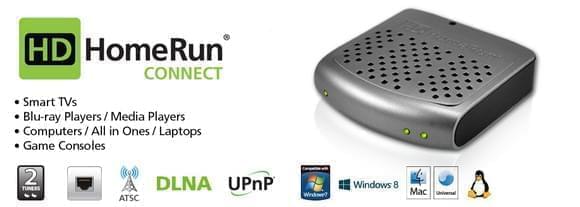SiliconDust’s HDHomerun CONNECT makes adding OTA TV to your home theater a breeze
May 14, 2015- Permalink

I recently added SiliconDust’s HDHomeRun CONNECT a.k.a. the HDHR4-2US to my over-the-air (OTA) test setup.
At first glance, there doesn’t appear to be much difference between the CONNECT and its older brother, the HDHomeRun Dual (HDHR3). The Dual is black with grey sides. The CONNECT’s grey with black sides. They both have network-attached dual ATSC/Clear QAM tuners.
The real difference lies under the hood and the improved tuners inside the CONNECT. As I’ve mentioned, my OTA setup is challenging, using reflected and side signals to get channels from both Toronto and Buffalo.
Though the HDHR3 handled this situation like a champ with most of the signals, some, like Buffalo’s WKBW and WNYO, did have problems with pixelation. However, these two stations are 83 and 79 miles away. So, given my odd situation and adding in that the Antennas Direct C2V is rated for about 50+ miles, means that the fact that the HDHR3 is grabbing them at all is a testament to the little tuner box.
I was eager to get my hands on the newer HDHomeRun CONNECT and see how the new kid on the block would compare to his older brother. It’s the Mark Wahlberg of tuners to the HDHR3’s Donnie.
The box it arrives in is small. About the size of a hardback dictionary. Safely packed inside, the HDHomeRun CONNECT is no bigger than a slightly wider pack of cards. How can something so small be so helpful to your home theater setup? But it is.
I checked it out with my reflected really-shouldn’t-be-working-but-it-does antenna config. I looked at SiliconDust’s configuration software, which includes details on signal strength, signal quality and symbol quality, The latter two show how clearly defined the digital data is and the amount of correct or corrected data over the last second. I could immediately see several improvements and those problem channels, WKBW and WNYO, were rock solid.
Antennas Direct had also sent me their DB4e antenna to check out. This beauty of an antenna, rated for 65+ miles was going to give the HDHomeRun CONNECT a different workout.
I decided to aim the DB4e southeast, pointing at Buffalo and Rochester. Again, this was going to be a challenge for any setup. As I mentioned here, by balcony is not facing south toward any of the Toronto or Buffalo towers. I’m facing east. So aiming southeast toward Buffalo meant that the antenna was pointing through a window on my balcony, through a curtain, into the dining area, though another curtain and finally another window. Grabbing signals this way would be a job for Harry Houdini.
Or it would be a job for the SiliconDust HDHomeRun CONNECT and the Antennas Direct DB4e. My Buffalo signals came in even stronger and rock solid. The closest one is 52 miles away. I was now solidly getting WPXJ in Batavia. It’s 89.3 miles away and is classified at my location as 1Edge, which means the signal is not line-of-sight but has a single edge diffraction on its way to my place. Previously, I would only get it on the warmest days due to a phenomenon known as tropospheric propagation. The HDHomeRun CONNECT locked it in steady and i’s now a regular in my channel lineup. With the southeast-facing setup, the Toronto signals are due south through the aforementioned glass and curtains, a wall, one more apartment unit and another wall. All but one of my Toronto signals were reachable with this setup.
I’ve been testing it for a few weeks now and the HDHomeRun CONNECT and its DB4e partner have even been close to locking in WBXZ and that’s even on cold spring nights when tropospheric propagation isn’t really a factor . It’s a low power 15kW station that’s 62 miles away and like WPXJ, a 1Edge. Very few people in Toronto get it on a regular basis. The fact that the HDHomeRun CONNECT is this close to locking into it — through two sets of glass and curtains — gives you an idea about the tuners.
So in both the reflected and obstructed southeast-facing setups, the HDHomeRun CONNECT was an improvement over the HDHR3, which is by no means a slouch in any category either. The HDHomeRun CONNECT is a champ at locking in previously troublesome stations, with measurable improvement in signal and symbol quality.
Why is the HDHomeRun family so good for OTA setups? There are tuners available that can be inserted into your computer, just like you would insert a video card. This means that you have to run the coax cable from your antenna all the way to your computer. There is a loss of signal quality over long lengths of coax. In the case of the HDHomeRun series of OTA tuners, they are network devices just like routers or print servers. So you can place the HDHomeRun right at the point where your coax cable enters your home. This means you can get the shortest run of coax possible, reducing the amount of signal loss. The HDHomeRun then converts the TV signal into one that can be transferred over your home network and there’s no loss of quality at that point. Being a networked tuner also means that depending on the software, you can watch the TV signals on a variety of networked-attached devices in your home. The HDHomeRun EXTEND, also adds in transcoding, which makes the resulting signals easy to stream wireless to, say, someone sitting on the couch with a tablet. SiliconDust is also working on their own PVR software. Finally multiple HDHomeRun’s can also be used to increase the number of tuners available to record or watch TV.
As an Antennas Direct Ambassador, I’ll be testing their new antennas as they come out. The HDHomeRun CONNECT is a great addition to my test bench and I highly recommend it for anyone looking to add over-the-air TV to their media center setup.